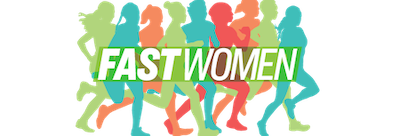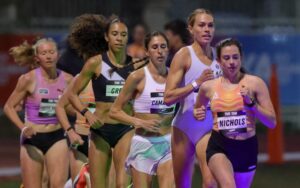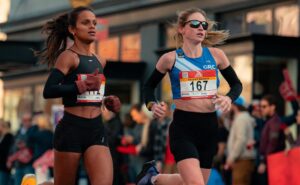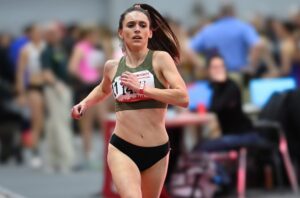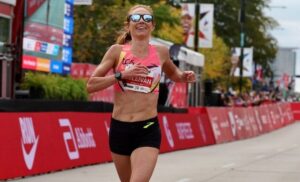
Courtney Frerichs discusses her decision to leave the Bowerman Track Club
Courtney Frerichs announced last week that after seven years, she has left the Bowerman Track Club. Frerichs, 30, is now training with the North Carolina-based Puma Elite team, coached by her former BTC teammate, Amy Cragg, and her husband, Alistair Cragg. Despite the move to a Puma-sponsored group, Frerichs will continue to be sponsored by Nike. Frerichs’ husband, Griffin Humphreys, recently took a coaching position with the Puma team.
Frerichs won silver medals in the steeplechase at the 2021 Olympic Games and the 2017 World Championships. She set the American record in the steeplechase, 8:57.77, at the 2021 Prefontaine Classic.
In December 2022, she had surgery due to osteochondral defects in her talus and tibia and to remove a piece of cartilage that had broken off and was causing a lot of her pain. And at the 2023 USATF Championships in July, Frerichs fell in her steeplechase prelim but still advanced to the final. During the race, she suffered a different injury in the same ankle, tearing two ligaments and developing a bone bruise in her fibula. She withdrew from the meet prior to the final.
This interview has been edited and condensed.
In 2021, it seems like you were on top of the world. But since then, you’ve dealt with a lot of ups and downs. Can you take me through some of them?
You said it well. During the summer of 2021, I had a dream season. Shortly following that, I found out that my college coach (Jimmy Butler), who still, to this day, is probably the most important person in my running career, had stopped treatment for cancer. He passed away in December of that year. I spent a lot of that fall and winter in Albuquerque, taking in those last moments with him.
That kind of was the start of almost two years of struggle. I basically channeled everything into running at that point, [thinking] I’m going to get back on the podium for him. I don’t think I really knew any other way to handle the grief, but it didn’t end up being the best thing. I went up to altitude unknowingly having celiac disease and ended up with some really low iron levels coming out of that camp. Once we figured that out, things were trending in a better direction.
Worlds was solid. (She finished sixth.) I ended up getting Covid there, though, and that derailed the rest of the season. Like a lot of people, I thought that I could push through it, but I went on to have a major struggle with training the rest of that fall. I also learned that I had a pretty significant injury from the 2022 season. I was just treating it as an ankle sprain, and it turned out that it was a bigger issue that needed surgery.
I had the surgery in December of 2022, which ended up being a blessing in disguise in regards to the long Covid issue, because taking that time off allowed me to finally reset. Coming back from surgery, in hindsight, I rushed things a bit to try to give myself a shot at making the world championships team. I had the world standard and wanted to give it a go but honestly probably wasn’t ready. It’s one thing to get back to running, but I think it’s another to get back to steeplechasing, when you’ve had injuries.
I ended up reinjuring my ankle at USAs, I think when I fell, but we don’t really know for sure. I ended up missing another month of training. I scraped together a little bit of a track season at the end of the outdoor season, mostly with 1500s and miles. Physically I was in a pretty good place, but we decided to take another reset and focus on restarting things this fall and just get a foundation laid.
When I say it out loud, it does seem like a lot of things back to back to back. I think I’m on the other side of it now. Things have been going a lot better.
It must have been really hard to put in all of the work but not see the same level of results you were used to.
The summer was really challenging. I was so far off of the level of expectation I have for myself. It was eye-opening, too. I’ve kind of realized how quickly the sport moves without you. There were some really exciting performances to watch, and it’s never fun to do it from the sidelines. But it was also really motivating. I’m coming back this time around for myself and not anything to do with other people’s expectations of me, or feeling like there’s that kind of pressure. I’ve been at hopefully my lowest low, and I feel really motivated to come back this time.
How did the Bowerman Track Club’s move to Eugene affect you?
It was pretty challenging. I think it affected each individual athlete on the Bowerman Track Club a different way, depending on their circumstances. I’m married, I have a husband, and we very much had built a lot of stability in Portland. We had a home, we had a community that we had created. It kind of felt like we were losing all of that with the move.
At first, my husband stayed in Portland, and I went down to Eugene. Just given the history and the success that I had with Bowerman, I wanted to really give it a fair go. Obviously I had a lot of other struggles going on at the time, so I think that that played a big part in it, too. But I was pretty unhappy, so he ended up leaving his coaching job at Portland State and coming down to Eugene with me. We just really struggled to re-create that environment that we had made for ourselves in Portland. It felt like we kind of took a step back in life and went from feeling like we’d made a lot of adult moves to something that was really temporary.
Given how much you move around, has it been hard over the years being married to someone who mostly has to do his job in person? Or was this the first time it became a bigger issue?
There have definitely been challenges with it, but he’s been so incredibly supportive of putting my career first. I think we both recognize that this is a pretty short time in our lives. But we also want him to be working towards something outside of my running, and that was a big struggle for us in Eugene.
Everything became very much about my running, and it had never been that way before. Especially when running is not going well, and then suddenly you feel like all the pressure is on me succeeding, and my entire identity became around running. We both recognized that it wasn’t healthy.
How did the opportunity with Puma Elite come about?
During August, we were over in St. Moritz, and he and I have had a really good relationship with Amy and Alistair for a really long time. They made sure we were okay when we moved out to Portland, because it was our first time really going out on our own. Alistair started the conversation, saying we have a baby on the way, and we’re going to need some help. We’d really love for you to be involved with it.
Griffin had done a few things with them prior, because he also works for Kimbia Athletics. He helped out at their Mammoth training camp for a week last year. Alistair really trusts him to step in in any place that they needed him to. He was excited about just being able to be back in a coaching-type role. It seemed like kind of a perfect situation, once I started to have some conversations with Alistair about how training would look if I started to work with them.
When did Griffin move to North Carolina for good?
We both went out at the same time, in November. I did a fall altitude camp in Park City, just to kind of take some space and make a final decision on things. I also wanted to do some fall altitude training. Looking at years past, that was something unique I had done on my own and it set me up for a good year.
When he made the decision he was going to take the job, was it pretty much a done deal that you were going to leave Bowerman? What was the order of events there?
Us committing to that situation was pretty simultaneous. It was probably sometime in October that I finally decided that I was going to leave. I had had a few different conversations with (Bowerman head coach) Jerry (Schumacher), kind of explaining where I was at with things. I wanted to keep the communication really open, I didn’t want to catch him off guard. I also wanted to see if there was a way to work things out. But ultimately, it wasn’t right.
We left things on really good terms. I was wanting to spend more time at altitude. Also, he’s made some changes to the training over the last couple of years, since 2021. I was really all in on it at first and wanted to give it a go. I personally just haven’t seen the results from it. Obviously there are a lot of other things that have been at play, so it could purely be coincidence, but I’ve definitely had a desire to get back to training in a way that I know works. Jerry likes to [use] a team approach, where everyone’s kind of doing the same thing. So what I was looking for wasn’t matching up with the setup that’s currently happening.
I look back, and I’m really thankful for all the time and really happy with how things went while I was there. But I also feel excited about this opportunity. Alistair puts it really well, he says he wants me to have a hand on the steering wheel at all times. Once I knew I was leaving, Griffin was like, “Okay, yeah, I want to do this, too.”
How much did the smaller roster at Bowerman factor in? Did that make it easier to leave?
It didn’t necessarily make it easier. I think our women’s team, especially, did a good job of communicating with one another around where everyone was at. I was actually probably the first to come out and say, “Hey, I’m not sure I’m going to come back.” I don’t know that that caused the spiral effect, we all tried to be like, “Everyone needs to take a step back and decide what’s best for themselves.”
I think it was sad to see the numbers dwindle [because] I was able to be a part of the very beginning of the women’s team growing to what it was. And I had the opportunity to get to know and work with a lot of incredible women. I do feel sadness about that, but it wasn’t necessarily a factor. For a lot of us that had been [with BTC] prior to Eugene, the new setup was different than what we went there for. For a long time, I just longed for what things had looked like before, and once I realized we weren’t going to be able to go back to what it was before, that gave me a lot of clarity in terms of okay, change is happening, what do I want the change to be?
So Amy and Alistair will be your coaches, and how does Pascal Dobert fit in?
Pascal kind of has a consulting role with the team, doing some steeple stuff and some strength stuff. He will be writing all of my steeple training, which was another really big piece of things for me. The steeple is really important to me, and he also is a really important reason for a lot of my success at BTC. He stepped away from BTC (a little over a year ago), and I started to realize that was having a pretty big impact. I definitely wanted to get back to being able to work with him. It’s such a valuable thing to have a coach that’s run your event at the Olympic level, especially with it being such a technical event.
Will he be your strength coach, too?
He does some of my strength training, and then I do still work with Colleen Little, the PT I worked with at BTC. She was open to continuing to write a lot of my rehab and strength work.
And are you training with the Puma Elite team?
Yes. I lined up with them really well this fall. They have an incredible group of women who really welcomed me and were excited to have me around, which made the transition really nice. I’m here in Albuquerque with Taylor (Werner), Fiona (O’Keeffe), and Rose Harvey right now for altitude camp, and then some of the men are here as well. The sport is really hard, and doing it alone is even harder.
And Nike is okay with you training with a Puma-sponsored team?
I was definitely unsure how that conversation would go, but I called Paul (Moser), and we’ve always had a good relationship. He was fully aware that I had been pretty unhappy and was thinking about maybe making some changes, so he wasn’t caught off guard. They were really supportive and said, “As long as Puma is okay with it, we’re good with it. We’re glad you have a good plan and you’re excited.” That definitely was a big stress [lifted].
Are you feeling healthy now and like things are clicking?
Yeah, workouts are going super well. We were patient with things this fall and probably started even further back than we could have. But one thing that Alistair wanted was to have me train at the level my body was ready for, so things were very week to week. It’s definitely been surprising how things have snowballed and come together.
I was really hesitant to think about racing at all, and he really wants to have that conversation now because I’m comfortably running paces I haven’t touched since 2021. I think there’s some plans for maybe a couple indoor races that I definitely didn’t see coming, but I feel excited about.
Has it been tough to stay positive the past couple years? How have you gotten through all of it?
Yes, it has been tough. [I had] some serious doubts about ever getting back to the level I was. At so many times, I’ve felt so far from the athlete that ran 8:57. Thankfully I’ve continued to work with the sport psychologist who helped me make a lot of breakthroughs during the Olympic year. That relationship has been so incredibly important throughout all of this, even more so, probably, than the Olympic year.
Also just taking a step back and making goals that are relevant for that moment. This summer, I was really tempted to throw the towel in once I got hurt again and just be done for the year. But once it was looking like I was going to be able to run again, I saw an opportunity to work on trusting my body’s ability to just do workouts again, without having the pressure of a race coming up. I forced myself to do some uncomfortable things, essentially.
And what do you think of North Carolina so far?
I really loved the fall there. I really enjoyed my time in Oregon, but as I got older, the cold rain did get really hard and my body really struggled to train in it. I’m appreciating the better weather and the running in the area is super nice.
I should add that I’m doing a little bit of a hybrid situation. Griffin and I are actually building a house in Park City. So I’ll spend, tentatively, like April to November in Park City and then [a stretch] in North Carolina, as well as a spring sea-level camp in North Carolina. He’ll be a bit more transient this time around, going back and forth wherever Alistair and Amy need him to be. So, for instance, he’s the coach that’s feet on the ground for this altitude camp in Albuquerque.
When you’re in Park City, who will you be training with?
I think that some of the team will be coming to Park City at times for altitude as well. There’s a chance that I’ll be doing some things on my own, and that was kind of why I went to Park City in October on my own, too, just to see how it was going to go. But I also have a pretty good community of people there and there are a lot of professional runners who make their way through.
I don’t expect the schedule to look too different from what it’s been in the past. When I started to dive into my best years, those were the years I was spending almost seven months at altitude. So we looked at it and thought, “Why not make that home?” It sort of fell into place, and we’re really excited about that piece of it.

